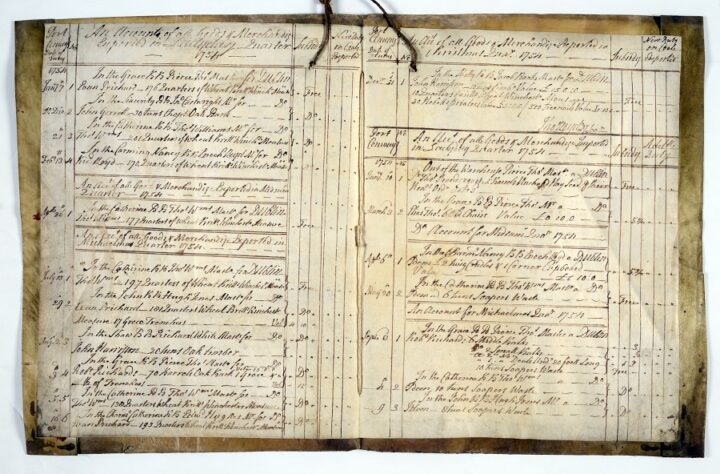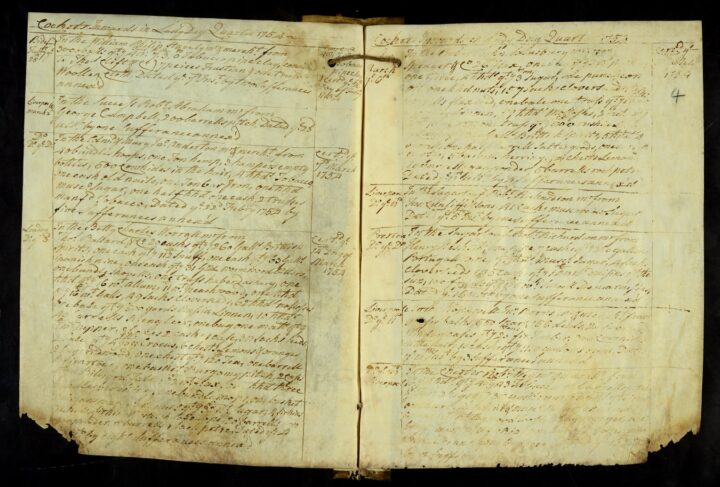How to look for records of... Merchant trade records: port books 1565-1799
How can I view the records covered in this guide?
How many are online?
- None
1. Why use this guide?
Port books record customs duties paid on goods imported and exported through English and Welsh ports. The books were kept by local customs officials at ports all around England and Wales between 1565 and 1799.
Use this guide to find out more about port books and how to locate books for individual ports among the collection held at The National Archives. You can use port books to find information on:
- the development of trade between the 16th and 18th centuries in England and Wales
- ships and their masters
- merchants and the goods they traded
Occasionally you can also find information on some or all passengers on a ship.
2. About port books
Although there are some 20,000 port books among our records, many did not survive and there is no guarantee you will find a port book for a particular date and port. Furthermore, most ports had stopped using port books by 1750 so their number drops off significantly after this date. For example, there are no London port books for 1697-1799. Of those that do survive, for any port, many are in a poor state of preservation.
Before 1600 many entries in port books are in Latin – by 1660 most are in English.
2.1 Who recorded entries in port books?
There were several different types of local customs officials who made entries in port books:
- the Collector or ‘Customer’ – recorded all goods exported or imported and all moneys received, for which he issued a cocket (receipt)
- the Controller – made a similar record but did not receive the payments
- the Searcher – appointed to prevent fraud, he examined the goods and created a warrant to show he had done so
- the Surveyor – appointed to check the work of the Searcher (this second check was introduced in the 17th century)
Exchequer officials checked warrants, cockets and the other records created for each entry to make sure everything checked out.
2.2 What was recorded?
Entries in port books can include:
- the name of the ship and its tonnage
- the name of the master of the ship
- whether the ship was British built (18th century books only)
- the ship’s destination or port to which it was sailing next (false information was sometimes supplied, for instance if a merchant was infringing the rights of a monopoly trading company)
- the ship’s port of registry and its port of departure
- the names of the merchants (sometimes giving the merchant’s mark) and whether they were aliens (aliens paid 25% higher duty)
- date on which duty was paid (not the date of arrival or unloading)
- a description of the goods
- the amount of duties paid (based on the official valuation as laid down in the Book of Rates)
There are distinctions, however, between entries for overseas trade and entries for coastal (domestic) trade.
For overseas trade, they record:
- imports and exports
- the issue of cockets (receipts) for payment of duty
For coastal trade, they record (at the port of unloading)
- exports only
- the issue of the certificate declaring that the cargo was not subject to duty, as it was not overseas trade
2.3 What do port books tell us about trade?
Smuggling, evasion and fraud mean that port books do not provide a full picture of trading activity. However, they are still a vital source of evidence for studies of the development of trade, especially in the 16th and 17th centuries. They are particularly valuable for those periods when the customs were farmed out (1572-1588 and 1585-1590 for certain ports and generally after 1605).
When customs were farmed out, general accounts of the farm syndicates appear in the ‘declared accounts’ in E 351 and AO 1, but be aware that the summary totals for each port were not recorded on the ‘enrolled accounts’ in E 356.
3. How to search for individual port books
Port books at The National Archives are held among the records of the Exchequer, in record series E 190. You can search for individual books, each of which has a unique document reference, in our catalogue. You will need the document reference to see the record itself. The records are not available to view online so to see them you will have to either visit us in Kew or, if you can locate document references, order copies.
Begin by going to the E 190 catalogue description from where you can search the series using dates and keywords. Use the following types of keywords:
- name of port
- creator of the book (controller, collector or searcher)
- type of trade (overseas or coastal, import or export)
Ports were grouped together under ‘head ports’. Examples of head ports include Chester, Newcastle and Southampton and groups of so-called ‘lesser ports’, also referred to as ‘lesser harbours’, ‘creeks’ or ‘havens’, are found within the port books for these head ports. Among the ports grouped under Chester, for example, are Liverpool, Carnarvon, Conway and several others. There is an ‘Index of creeks and lesser harbours’ in the printed version of the E 190 catalogue listings (pages 564-566 of E 190 Vol 1), held in the Map and Large Document Room at The National Archives in Kew. However, the online catalogue listings should include the names of lesser ports as well as the head ports.
Some port books are held in local archives. Search for “port books” in our catalogue (which includes listings for other archives around the country), filtering search results to ‘Other archives’ or find contact details for archives elsewhere using our Find an archive tool.
A number of port books have been transcribed and published. It may prove much easier to seek out published port books before searching for the original records at The National Archives in Kew or elsewhere. E L C Mullins’ Texts and calendars, ‘Royal Historical Society’ (1983), held in the Map and Large Document Room at The National Archives in Kew, contains some listings for published or printed port books. Alternatively, local history societies may be a good place to enquire (you can find a directory of local history societies on the British Association for Local History website).
4. Understanding and interpreting entries in the books
Information in the port books can be difficult to read and interpret. Before 1600 many entries in port books are in Latin though by 1660 most are in English.

A page from a searcher’s port book for Conway, whose head port was Chester, from 1754 (document reference E 190/1427/1).
4.1 Tips and pitfalls
When examining port books it is worth bearing the following in mind:
- there might be more than one ship with the same name so even if other details from the port books match up, you can’t be sure it is the same ship
- the names of foreign masters or merchants, given verbally, might be written down wrongly or anglicised
- merchants and masters are sometimes described as native (‘indigenus’, often abbreviated to ‘Ind’) or alien (‘alienigena’ often abbreviated to ‘Al’)

A page of from a controller’s port book for Chester from 1754 (document reference E 190/1427/7).
4.2 Useful published sources for interpreting port books
The following books, all available from The National Archives library, may help you to identify unfamiliar descriptions of goods and quantities occurring in the port books:
- R E Zupko, A Dictionary of English Weights and Measures (1968)
- S W Beck, The Draper’s Dictionary: A Manual of Textile Fabrics, Their History and Applications (1886)
- N S Gras, The Early English Customs System (1918) which includes the 1507 Book of Rates, listing commodities and duties payable
- A Millard, Analyses of Port Books Recording Merchandises Imported in the Port of London by English and Alien and Denizen Merchants for Certain Years Between 1588 and 1640
(1960) - T S Willan (ed), A Tudor Book of Rates (1962)
- H Crouch, A Complete View of the British Customs (1755) which lists rates of duty from 1660 onwards
5. Passengers in port books
Names of passengers do not normally appear in port books but there are some exceptions to this:
- Before 1678 some passenger names are in the ‘Licences to pass beyond the seas’ which you can browse in E 157.
- If people had to pay duty on goods they were shipping, their names are sometimes in the port books. This applied to emigrants such as those travelling to America – you can find names in Peter Coldham’s Complete book of emigrants series.
- Traders are sometimes listed in port books. For instance a Weymouth port book (E 190/875/8) names 26 ‘planters’, sailing to New England in 1633, with a note that they had been allowed to export ‘diverse sorts of household stuff, apparell & other provisions’ to the value of £960 6s 8d, free of duty.
There is an index of Ships, Merchants and Passengers to the American Colonies, 1618-1668 which includes names taken from port books (mainly those of London and Bristol).
6. Related records
To study customs records from before and after the time span of the port books (1565-1799) you will need to consult records from other departments and series. Port books effectively became redundant after 1750, by which time most ports had ceased sending them in.
6.1 Particulars of customs accounts, c1272-c1830
Particulars of customs accounts in E 122 contain details of duties paid at particular ports and subsidiary accounting documents (including cockets).
Search E 122 using the name of the port. Records include names of customs officials, merchants and details of goods. They are dated by regnal year.
6.2 Registers of imports and exports from 1696
The Board of Customs introduced registers of imports and exports in 1696. These registers are in CUST 2-17 and CUST 22-37 but can only be searched in our online catalogue by year.
6.3 Mainland English, Scottish and Irish outport records, 1660-1988
These records make up a division within the CUST department and consist of 46 series of records of the daily work and business conducted at each port, but not duties paid on goods (each series covers between one and five ports). The records are mostly correspondence and letter books. Outports were any ports, other than the Port of London, where goods from foreign ships were traded and where the duties paid on the goods were received by a collector to be remitted to the Receiver General’s Office in London.
They are more fully described in Carson’s ‘Customs records as a source for historical research’ (see further reading below).
7. Further reading
Some of the publications below may be available to buy from The National Archives’ bookshop. Alternatively, search The National Archives’ library catalogue to see what is available to consult at Kew.
Books
- T S Willan, The English coasting trade 1600-1750 (Manchester 1938)
- N J Williams, The maritime trade of the East Anglian ports 1550-1590 (Oxford, 1988)
- R W K Hinton, The port books of Boston 1601-1640, Lincoln Record Society, vol L (1956), useful for understanding how the port books were compiled
Leaflet
- D M Woodward, ‘Port books’, Short guides to records No 22 (Historical Association, reprinted 1994)
Journals
- E Carson, ‘Customs records as a source for historical research’, Archives, vol XIII (1977-1978)
- R C Jarvis, ‘Sources for the history of ports’, Journal of transport history, vol III (1957-1958)
- R C Jarvis, ‘The archival history of the customs records’, Journal of the Society of Archivists, vol I (1955-1959)
- N J Williams, ‘The London port books’ in Transactions of the London & Middlesex Archaeological Society, vol XVIII (1956)